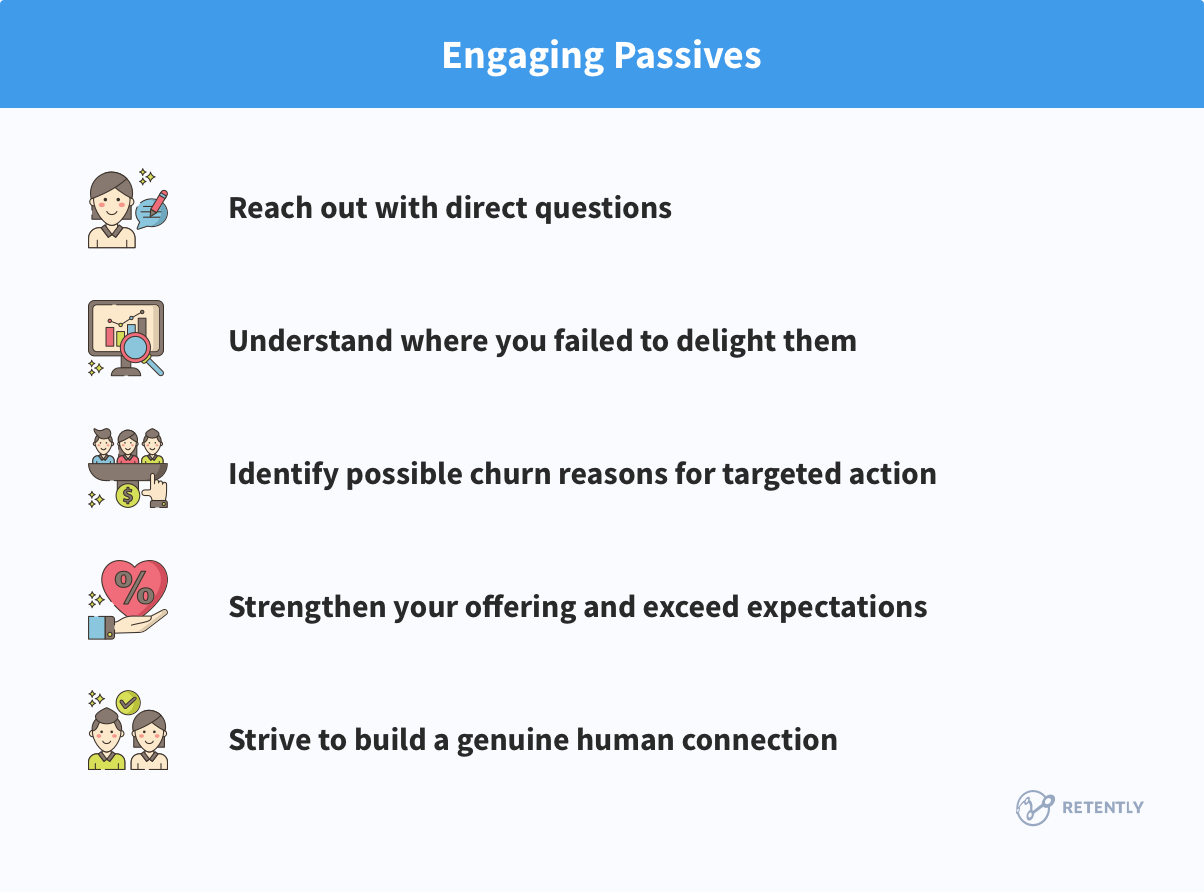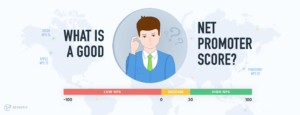Table of Contents
When you first start off with Net Promoter Score®, it seems reasonable to spend most of your time focusing on Promoters and Detractors – after all, these are the customers that have the strongest opinions about your product, service, or brand.
As a result, a considerable part of your audience – the Passives – is often neglected. Below, we’ve explained how Passives contribute to your NPS®, as well as the immense value you might find in paying more attention to their ideas and recommendations by adopting some of these actionable tactics.
Key Takeaways
- Passives are essential to NPS success, offering a chance to turn neutral customers into enthusiastic Promoters.
- Transparent communication and targeted incentives can effectively engage Passives, providing insights to improve products and services.
- Identifying where the business falls short with Passives helps refine offerings, boost customer satisfaction and reduce churn risk.
NPS by Respondent Segments
Let’s start from scratch and check out the three categories Net Promoter Score divides respondents into: Promoters, Passives, and Detractors.
Promoters
Promoters are enthusiastic customers who love your product. Of the three categories, Promoters are the most likely to spread positive word of mouth about your product, recommend it to their friends and make repeat purchases.
Their deep satisfaction makes them less likely to switch to competing brands, which helps keep your customer base steady and your revenue consistent. Additionally, because they value the great experience they get from your brand, they’re often willing to pay more and are less worried about prices.
To be considered a Promoter, a person needs to rate their likelihood of recommending your product, service, or company as a 9-10 out of 10.
As a business, you naturally aspire to have as many Promoters as possible. We’ve written previously on the importance of turning customers into Promoters, especially when it comes to Detractors.
Detractors
At the other end of the scale are the Detractors. These customers are so unhappy with your business that they’ll likely switch to a competitor as soon as the opportunity arises. The word-of-mouth feedback they spread is largely negative, potentially hurting your business.
To be considered a Detractor, a person needs to rate their likelihood of recommending your product, service, or company as a 0-6 out of 10. This means that even “somewhat satisfied” customers can be considered Detractors from the perspective of an NPS survey.
We’ve previously written about Detractors and the effect they can have on your business in the long term. We’ve also explained how you can win back Detractors with the right approach to outreach, problem-solving, and customer service.
Passives
The third customer category – the one first-time NPS users are most likely to ignore – is the Passives. These are people who rate their likelihood of recommending your product, service, or company as a 7-8 out of 10. It is worth mentioning that the number of Passives is not even included in the NPS formula, which is definitely one of the reasons Passives get constantly overlooked.
Passives are people with neutral feelings about your product. They might like it, but not quite enough to recommend it to anyone. They’ll probably keep paying their monthly bill, but there’s a risk of them churning if a better deal comes along. Moreover, they’ll rarely refer new customers.
Because of this, many marketers brush off Passives as the “neutral” part of the Net Promoter Score, viewing them as customers that aren’t much of a priority. After all, at first glance, they are neither an asset nor a liability to the growth of your business.
For growth-focused marketers that make use of Net Promoter Score, Passives are, however, a unique opportunity. Reach out to a Passive with the right approach, and you could convert them into an enthusiastic Promoter; use the wrong path and they could turn into a Detractor.
This makes your audience of Passives an unpredictable but valuable asset for your business.
Leveraging Your Passives: Trade Indifference for Opportunity
Below, we will explain how you can reach out to Passives to learn what prevents them from becoming Promoters. We will also share actionable tactics that you can use to convert your passive customers into enthusiastic Promoters for your brand.

1. Reach Out With Direct Questions
As strange as it might sound, it’s often easier to break the ice with a Detractor than to get in touch with a Passive.
The reason for this is simple: Detractors are, as a rule, more vocal about their interactions with your brand, so they will definitely reach out with complaints more often than a Passive who is regarded as a somewhat satisfied customer.
In this respect, Detractors would make their negative experience more noticeable, giving you a chance to make up for it. Unhappy customers are thus often waiting to hear from you, meaning a Detractor (who may feel upset because of poor service or what they perceive as a bad deal) is highly likely to open, read and respond to your email.
A Passive, on the other hand, might not view your product or service as a major priority in their lives. They might use it out of necessity, only use it rarely, or along with alternatives from your competitors. As a result, an outreach email can feel more like “just another message” than an attempt to repair a relationship.
This means that the best way to reach out to Passives is with a direct and transparent message leaving no space for neutrality. Ask about what you can do to improve their experience, what they’d like to see in your product or service, what their unique requirements are and how you can better serve them.
Often, all it takes is a short email with one to two NPS survey questions and a human touch to successfully reach out to a passive customer and convert them into a loyal, valuable Promoter.
Offer Incentives for Feedback
Incentives can boost feedback from passive customers who might not otherwise engage. A survey found that 18% of consumers are influenced by incentives when choosing brands.
Effective incentives include:
- Discount codes that encourage repeat purchases.
- Gift cards to thank customers for their feedback.
- Complimentary services that increase satisfaction with free upgrades or services.
- Extended trial periods, encouraging deeper engagement with additional service time.
Tailoring incentives to your customer base can greatly improve participation rates.
2. Understand Where You Failed to Delight Them
Passives can seem like a less urgent priority than Detractors, and in the short term, they often are. However, over the long term, Passives can provide extremely useful insights into how you can improve your product and strengthen your business.
Passive customers may be doubting whether to spread good word of mouth about you, but they are definitely willing to shop for a better value. Striving to learn more about customer needs can bring up the value these customers might be looking for. Besides, a Passive rating your product with a 7 or 8 is much closer to the Promoter scale than a Detractor giving you a 3 or 4. Therefore, an apparently less significant extra effort can result in an increased loyalty rate.
One example would be feature requests. Promoters, who are already happy with your product, are unlikely to wish for new features. After all, they’re pleased with what they have — any extras you decide to release in the future are just a bonus.
For a Passive, however, a specific new feature could be just what they are looking for. Listening to their feedback and adding it to your product or service can often be all it takes to earn their business for the long term. In some cases, it only takes a minor edit to an existing feature.
Better yet, if a Passive knows you added a specific feature or changed a particular aspect of your product based on their feedback, it creates a personal connection that separates your product or service from the competition. Hence, experimenting with some delighters might do the trick.
The result? A once neutral, passive customer could make a step forward to becoming an enthusiastic Promoter of your brand, and a more reliable customer.
3. Identify Potential Churn Reasons for More Targeted Action
While Passives are unlikely to damage your brand through negative word of mouth, there’s a serious risk that they could leave your business for a competitor if the right opportunity arises.
This means it’s important to be watchful and alert to opportunities for your competitors to pick away at your audience of Passives.
Key risks include:
- Discounts or aggressive pricing from other SaaS products in the same category as your own. Often, a small monthly discount is all it takes for a competitor to start picking away at your Passives, reducing your business while expanding their own.
- New features from competing products that you don’t or won’t offer due to other priorities in your roadmap. If your product lacks a major feature that a competing product offers, Passives could be some of the first to switch teams.
- Bad service. Sometimes, even a small service slip-up (such as a slow response to an email or support ticket) is all it takes for a Passive to leave for the competition, even if their service is no better. Poor service is one of the three leading reasons businesses lose customers.
- A frustrating experience with your product, ranging from a knowledge base that doesn’t adequately answer a specific question to a feature that doesn’t work as it is supposed to.
Once you’ve identified these risks, it’s time to look at complaints as opportunities and take action — something we’ve covered in the next step.
4. Strengthen Your Offering and Exceed Expectations
The final step in moving customers out of the passive category and converting them into highly satisfied Promoters is to strengthen, refine and improve your product or service to a point where the main barriers preventing Passives from giving a 9-10 score are no longer there.
Passives are there for you only as long as your business meets their requirements. Once they realize there is something that suits them better, they will show themselves out by switching to another brand. Predict and exceed their expectations by offering the best customer experience every single time – this is the only way forward.
Make them keep coming back for more and have your deals at the forefront of their minds. Be the one to set the benchmark for your customers’ expectations by understanding them even better than themselves, and the once unpredictable and quite hesitating Passives would become more than pleased to change camps and join your Promoters.
Consider the following strategies to convert Passives into Promoters:
- Simplify an overly complex interface to enhance user experience.
- Improve your service by providing faster and more effective customer support.
- Expand your knowledge base to answer a greater range of questions and assist customers better.
- Add unique features your competitors don’t offer, making your product more attractive.
- Revise your pricing based on the competition, especially since Passives are price-sensitive.
Because every customer has different needs, there’s no one-size-fits-all solution for turning all of your Passives into Promoters. However, by inviting their feedback, identifying issues, and improving your product, you can increase your ratio of Promoters to Passives.
5. Don’t Lose Sight of the Human Connection
Although not tackled as much as Promoters and Detractors, the Passives’ role in the success of your NPS campaign and business as a whole is undeniable. In this respect, they need to be regarded as merely an opportunity rather than be repaid with indifference, which, in turn, would indirectly encourage Passives to join the rows of Detractors.
Passives and loyalty are definitely not on the same page; however, you can make a difference by trying to build a genuine relationship, showing them that they mean more than just a pocket filler, that their opinion truly matters, and that you are there to offer an exclusive experience with their help.
The overall customer experience is no doubt important, but it’s the human connection that turns sticky. It’s about how you make your Passives feel that will really count. We are all out there for better deals, but even statistical data backs up the fact that relationships have more weight. Hence, 86% of customers would continue doing business with a company if an emotional connection with a customer service agent was in place; however, only 30% of them felt companies managed to establish that sort of emotional proximity during the year. This being said, one must dig deeper to be able to offer more than a product but an experience that is difficult to match.
Passives to Promoters: The Key to Growth
So, why should we focus on converting these Passives into Promoters? Simple – because turning a Passive into a Promoter will boost your business. Promoters are like your personal cheerleaders. They don’t just return themselves; they bring friends, family, and even coworkers along. This kind of organic growth is incredibly valuable because it’s based on genuine enthusiasm and trust.
Plus, it’s often easier and more cost-effective to win over a Passive than to try and change the mind of a Detractor.
Understanding who these Passives are can help you better connect with them. Watch for these usual signs of Passive customers:
- Satisfied but Not Excited: Passives are generally satisfied with your product or service, but they don’t feel strongly enough to promote it to others. They think it’s good but not great.
- Low-Engaged: They tend to engage less with your brand compared to Promoters. They might not follow your social media channels, open your emails regularly, or participate in loyalty programs.
- Price-Sensitive: Passives often have a keen eye on the value for money. They’re more likely to switch to a competitor if they perceive a better deal elsewhere.
- Silent Observers: They don’t typically provide a lot of feedback, positive or negative. They’re less likely to fill out surveys, write product reviews, or contact customer service unless there’s a significant issue.
Yet, despite being on the fence, Passives have the potential to become Promoters with the right engagement and improvements.
Identify Promoters, Passives, and Detractors with Retently
Retently makes sending customer surveys extremely easy. This allows you to find out what your customers really think about your brand and identify opportunities to develop and grow your business.
Start by registering a free trial account and surveying your customers with no contract, credit card, or long-term obligation required.



































 Alex Bitca
Alex Bitca 


 Greg Raileanu
Greg Raileanu 
 Christina Sol
Christina Sol 
